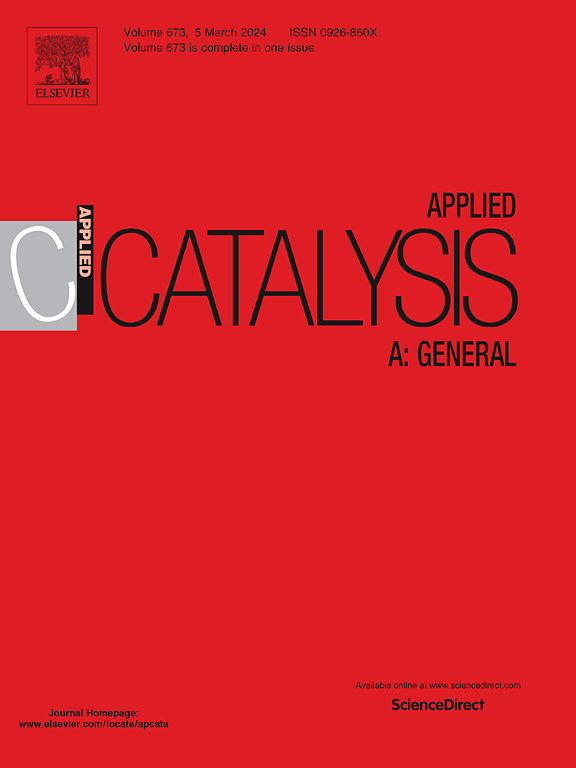掺铁碳化钼改善析氧反应中反应物的吸附
IF 4.8
2区 化学
Q2 CHEMISTRY, PHYSICAL
引用次数: 0
摘要
碳化钼具有与贵金属铂相似的d带中心和费米能级,是一种优异的析氢反应电催化剂。然而,Mo材料在水裂解过程中面临的主要挑战是析氧反应(OER)活性不理想。本文首次设计和制备了掺杂铁的碳化钼,由于其改善了对反应物的吸附,因此可以作为一种高效的OER催化剂。Fe-Mo2C@CN催化剂表现出优异的OER活性,需要223 mV的过电位才能达到10 mA cm⁻2的电流密度。同时,Fe-Mo2C@CN展示了水电解的潜力2.13 V 1000马 厘米⁻2和OER和工业条件下保持充分水解稳定:设有240 h 200马 厘米⁻1000和100 h 马 厘米⁻2以最小的性能下降。XPS结果表明,Fe的引入优化了Mo2C周围的电子结构。甲醇探针实验表明,Fe的掺入增强了OH*在催化剂表面的吸附,从而提高了OER催化性能。原位拉曼实验表明,Fe可能作为新的活性位点(FeOOH)催化反应,进一步提高催化剂性能。此外,理论计算和动力学模拟表明,铁改善了OH -⁻的吸附,增加了Fe-Mo2C@CN上OER反应物的浓度,加速了OER过程。本文章由计算机程序翻译,如有差异,请以英文原文为准。
Iron-doped molybdenum carbide for improved reactants adsorption in oxygen evolution reaction
Molybdenum carbide is an excellent HER (Hydrogen evolution reaction) electrocatalyst because of its d-band center and Fermi level, which are similar to the precious metal Pt. However, the main challenge faced by Mo materials in water splitting is the unsatisfactory oxygen evolution reaction (OER) activity. Herein, iron-doped molybdenum carbide is designed and fabricated for the first time as an efficient OER catalyst due to improved reactant adsorption. The Fe-Mo2C@CN catalyst exhibits excellent OER activity, requiring an overpotential of 223 mV to achieve a current density of 10 mA cm⁻2. Simultaneously, Fe-Mo2C@CN demonstrates a water electrolysis potential of 2.13 V at 1000 mA cm⁻2 and maintains full hydrolytic stability under OER and industrial conditions: it operates for 240 h at 200 mA cm⁻2 and 100 h at 1000 mA cm⁻2 with minimal performance degradation. XPS results reveal that the introduction of Fe optimizes the electronic structure around Mo2C. Methanol probe experiments show that Fe incorporation enhances the adsorption of OH* on the catalyst surface, thereby improving OER catalytic performance. In-situ Raman experiments indicate that Fe may act as a new active site (FeOOH) to catalyze the reaction, further enhancing catalyst performance. Additionally, theoretical calculations and kinetic simulations demonstrate that Fe improves OH⁻ adsorption by the catalyst, increasing the concentration of OER reactants on Fe-Mo2C@CN and accelerating the OER process.
求助全文
通过发布文献求助,成功后即可免费获取论文全文。
去求助
来源期刊

Applied Catalysis A: General
化学-环境科学
CiteScore
9.00
自引率
5.50%
发文量
415
审稿时长
24 days
期刊介绍:
Applied Catalysis A: General publishes original papers on all aspects of catalysis of basic and practical interest to chemical scientists in both industrial and academic fields, with an emphasis onnew understanding of catalysts and catalytic reactions, new catalytic materials, new techniques, and new processes, especially those that have potential practical implications.
Papers that report results of a thorough study or optimization of systems or processes that are well understood, widely studied, or minor variations of known ones are discouraged. Authors should include statements in a separate section "Justification for Publication" of how the manuscript fits the scope of the journal in the cover letter to the editors. Submissions without such justification will be rejected without review.
 求助内容:
求助内容: 应助结果提醒方式:
应助结果提醒方式:


